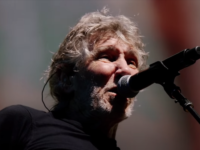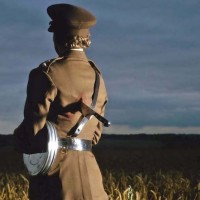Over the years, The Wall — and its unlikely advance hit single “Another Brick in the Wall (Part 2)” — have become an accepted part of the Pink Floyd iconography. But it wasn’t always like that.
In fact, as Dave Thompson’s new book Roger Waters: The Man Behind the Wall delineates in this exclusive excerpt, there was a lot riding on the band’s decision to release a single at all.
In some ways, the entire album project relied upon on the success of this increasingly rare 45 release.
Time tells us, of course, that “Another Brick in the Wall (Part 2)” would become a chart-topping smash. But what went into that decision, and what ultimately did its success mean for Pink Floyd?
After one more album with Waters, 1983’s The Final Cut, the classic-era group break apart. Today, Waters tours The Wall as a solo project.
Here’s a look into a critical moment that held so many harbingers for Pink Floyd …
 The following is an excerpt of Roger Waters: The Man Behind the Wall by Dave Thompson, published by Backbeat Books (2013), an imprint of Hal Leonard Performing Arts Publishing Group. Reprinted here with permission of the publisher.
The following is an excerpt of Roger Waters: The Man Behind the Wall by Dave Thompson, published by Backbeat Books (2013), an imprint of Hal Leonard Performing Arts Publishing Group. Reprinted here with permission of the publisher.
The release of Pink Floyd’s first British single in a decade — following ten years of steadfastly and purposefully snubbing the medium — was guaranteed a modicum of success whatever it might have sounded like. Mere curiosity would ensure that, at least, but the British media pushed it to the point of a national event. And once people actually heard the thing, there was no holding it back.
Back in the early 1970s, when Pink Floyd first enacted their injunction against 45 rpm tasters for new LPs in the UK, they were in fine company. Led Zeppelin had started the trend, but so many others were quick to follow, with both Yes and Emerson Lake & Palmer joining the Floyd in the exclusive no-singles club. Other bands — the likes of Black Sabbath, Genesis, and Deep Purple — were not quite so stringent, and all three would enjoy occasional hits. But they accepted 45s as a requirement of their contracts and made no effort whatsoever to promote them. They made it plain that singles were the record company’s plaything and had nothing to do with the band — for they were all serious musicians, with no time for the frivolities of the weekly televisual antics of Top of the Pops and teenybop followings.
By the late 1970s, however, the worm had started to turn. ELP bounced back into action in 1977, after three years of hiatus, and promptly scored a massive UK hit with their rendition of Aaron Copland’s “Fanfare for the Common Man.” Yes released their most rocking long-player yet, Going for the One, and racked up a brace of short, sharp hits. Genesis shed front man Peter Gabriel and celebrated when “Follow You Follow Me” made its way onto the British chart.
Suddenly a hit single was no longer something for musicians to feel ashamed of, and the spotlight now turned on making sure that a band’s latest album had something that could be released as a single. ELP had to ruthlessly edit “Fanfare for the Common Man” down to fit onto a three-minute seven-inch, but even if Pink Floyd had been of a mind to join them, nothing on Animals could have been similarly sliced. The Wall, however, was a different proposition. Twenty-five tracks spread across four sides of vinyl wasn’t simply the most generous offering the band had ever made, it was also their first to be positively bristling with potential hits, a point that Bob Ezrin took it upon himself to belabor in his conversations with the band.
He was a firm believer in the importance of singles, not necessarily for their “hit potential,” but for the extra exposure they brought to a project, for the ease with which they could be picked up by DJs and spun into rotation without them having to first wade through an entire LP in order to find something suitable.
“Another Brick in the Wall (Part 2)” was the lucky, and exquisitely well-chosen, first choice. Riding in, as do so many of Pink Floyd’s signature numbers, on a distinctive Waters bass line (which in this case bore a striking resemblance to the super funk faux disco of the Climax Blues Band’s 1976 hit “Couldn’t Get It Right”), “Another Brick in the Wall (Part 2)” had everything a hit single could demand: an easily digestible message that was likewise easy to identify with, a chorus that was custom built for mass sing-alongs, and a mass sing-along of its own in the shape of the piping tones of the Islington Green School crowd.
And when more than one bemused listener described it as sounding like something from the soundtrack to Lionel Bart’s Oliver! — that glorious tout ensemble chorale piece in which the titular hero’s request for more food is greeted by a stomach curdling litany of dire threats and punishments — maybe that opened another door through which a formative influence on The Wall could squeak. The schoolteacher who humiliates The Wall’s hero by reading aloud his poetry to the class is not at all far removed from the bullying beadle who makes the orphan Oliver Twist’s life such a misery.
The sentiments of the song are reversed, however. In Oliver!, the song threatens dreadful consequences for the boy. In “Another Brick in the Wall (Part 2),” another in that glorious line of anti-school songs whose lineage stretched back to Alice Cooper’s similarly schemed “School’s Out” (which was also a Bob Ezrin production, of course), the boot is on the other foot. It is the teacher who is being answered back to.
So there was a lot to think about, and a lot to love. Released in the UK on November 16, 1979, “Another Brick in the Wall (Part 2)” sold 340,000 copies in its first week, steamrollering to the top of the chart within a week, and remaining there for the rest of the year. In America, it added another month at the top, and suddenly a band that had never cared two hoots for hit singles was closing out the decade with one of the biggest smashes of the age, and every other hit-hungry hopeful of the day, from Blondie to Paul McCartney, from Madness to Michael Jackson, saw their own latest offerings scattered in Floyd’s wake. All that before the main attraction had even hit the stores.
Riding the back of the hit single (but confident that it would have done so regardless), The Wall demolished all before it, its success not only vindicating Waters’s decision to so radically alter the course of Pink Floyd, but also sowing the seeds for the events of the next few years.
[amazon_enhanced asin=”B004ZN9W5M” container=”” container_class=”” price=”All” background_color=”FFFFFF” link_color=”000000″ text_color=”0000FF” /] [amazon_enhanced asin=”B00009V7VA” container=”” container_class=”” price=”All” background_color=”FFFFFF” link_color=”000000″ text_color=”0000FF” /] [amazon_enhanced asin=”161713564X” container=”” container_class=”” price=”All” background_color=”FFFFFF” link_color=”000000″ text_color=”0000FF” /] [amazon_enhanced asin=”B00004SVID” container=”” container_class=”” price=”All” background_color=”FFFFFF” link_color=”000000″ text_color=”0000FF” /] [amazon_enhanced asin=”B004ZNAXX2″ container=”” container_class=”” price=”All” background_color=”FFFFFF” link_color=”000000″ text_color=”0000FF” /]
- Ernesto Cervini’s Turboprop, “When I Fall” (2024): Video premiere - March 15, 2024
- Disaster Pony,“Dead Neon & The Noon Sun” from ‘Disaster Pony’ (2024): Video premiere - February 27, 2024
- Christopher Hoffman, “Farewell Forever” from ‘Vision Is The Identity’ (2024): Streaming premiere - February 19, 2024




